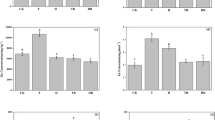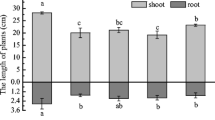Abstract
Background and aims
Microbe-assisted phytoremediation is particularly effective for organic pollutants. The leguminous shrub Cytisus striatus (Hill) Rothm. has been proposed as a candidate species for the rhizoremediation of hexachlorocyclohexane (HCH)-contaminated sites. The aim of this study was to improve the performance of this species using microbial inoculants.
Methods
C. striatus was grown in substrates contaminated with 0, 10 and 35 mg HCH kg−1 for 8 weeks. Plants were either not inoculated (NI), or inoculated with the endophyte Rhodococcus erythropolis ET54b and the HCH-degrader Sphingomonas sp. D4 (isolated from a HCH-contaminated soil) on their own or in combination (ET, D4 and ETD4).
Results
Inoculation with both bacterial strains (ETD4) resulted in decreased HCH phytotoxicity and improved plant growth. HCH-exposed plants inoculated with ETD4 presented a 120–160 % increase in root, and 140–160 % increase in shoot biomass, and led to a decrease in the activities of enzymes involved in anti-oxidative defence. APOD activity was reduced by up to 37 % in shoot tissues and 25 % in root tissues, and corresponding activities of SOD were reduced by up to 35 % and 30 %. HCH dissipation was enhanced in the presence of C. striatus but no significant effect of microbial inoculants was observed.
Conclusions
Inoculating C. striatus with this combination of bacterial strains is a promising approach for the remediation of HCH-contaminated sites.





Similar content being viewed by others
References
Abhilash PC, Singh N (2010a) Withania somnifera dunal-mediated dissipation of lindane from simulated soil: implications for rhizoremediation of contaminated soil. J Soils Sediments 10:272–282
Abhilash PC, Singh N (2010b) Effect of growing Sesamum indicum L. on enhanced dissipation of lindane (1,2,3,4,5,6-hexachlorocyclohexane) from soil. Int J Phytoremediat 12:440–453
Becerra-Castro C, Kidd PS, Prieto-Fernández Á, Weyens N, Acea MJ, Vangronsveld J (2011) Endophytic and rhizoplane bacteria associated with Cytisus striatus growing on hexachlorocyclohexane-contaminated soil: Isolation and characterisation. Plant Soil 340:413–433
Bergmeyer HU, Gawen K, Grassl M (1974) Enzymes as biochemical reagents. In: Bergmeyer HU (ed) Methods in enzymatic analysis. Academic, New York, pp 425–522
Breivik K, Pacyna JM, Münch J (1999) Use of α-, β-, and γ-hexachlorocyclohexane in Europe, 1970–1996. Sci Total Environ 239:151–163
Calvelo-Pereira R, Camps-Arbestain M, Rodríguez-Garrido B, Macías F, Monterroso C (2006) Behaviour of α-, β-, γ-, and δ-hexachlorocyclohexane in the soil-plant system of a contaminated site. Environ Pollut 144:210–217
Calvelo Pereira R, Monterroso C, Macías F, Camps-Arbestain M (2008) Distribution pathways of hexachlorocyclohexane isomers in a soil-plant-air system. A case study with Cynara scolymus L. and Erica sp. plants grown in a contaminated site. Environ Pollut 155:350–358
Calvelo Pereira R, Monterroso C, Macías F (2010) Phytotoxicity of hexachlorocyclohexane: effect on germination and early growth of different plant species. Chemosphere 79:326–333
Chaudhry Q, Blom-Zandstra M, Gupta S, Joner EJ (2005) Utilising the synergy between plants and rhizosphere microorganisms to enhance breakdown of organic pollutants in the environment. Environ Sci Pollut Res 12:34–48
Chekol T, Vough L, Chaney R (2002) Plant-soil-contaminant specificity affects phytoremediation of organic contaminants. Int J Phytoremediat 4:17–26
Chhikara S, Paulose B, White JC, Dhankher OP (2010) Understanding the physiological and molecular mechanism of persistent organic pollutant uptake and detoxification in Cucurbit species (Zucchini and Squash). Environ Sci Technol 44:7295–7301
Dettenmaier EM, Doucette WJ, Bugbee B (2009) Chemical hydrophobicity and uptake by plants roots. Environ Sci Technol 43:324–329
Gao Y, Zhu L (2004) Plant uptake, accumulation and translocation of phenanthrene and pyrene in soils. Chemosphere 55:1169–1178
Gerbling KP, Kelly GJ, Fischer KH, Latzko E (1984) Partial purification and properties of soluble ascorbate peroxidases from pea leaves. J Plant Physiol 115:59–67
Gerhardt KE, Huang XD, Glick BR, Greenberg BM (2009) Phytoremediation and rhizoremediation of organic soil contaminants: Potential and challenges. Plant Sci 176:20–30
Germaine KJ, Keogh E, Ryan D, Dowling DN (2009) Bacterial endophyte-mediated naphthalene phytoprotection and phytoremediation. FEMS Microbiol Lett 296:226–234
Glick BR, Penrose DM, Li J (1998) A model for the lowering of plant ethylene concentrations by plant growth-promoting bacteria. J Theor Biol 190:63–68
Huang XD, El-Alawi Y, Penrose DM, Glick BR, Greenberg BM (2004) Responses of three grass species to creosote during phytoremediation. Environ Pollut 130:453–463
Kidd PS, Prieto-Fernandez A, Monterroso C, Acea MJ (2008) Rhizosphere microbial community and hexachlorocyclohexane degradative potential in contrasting plant species. Plant Soil 302:233–247
Kidd PS, Barceló J, Bernal MP, Navari-Izzo F, Poschenrieder C, Shilev S, Clemente R, Monterroso C (2009) Trace element behaviour at the root–soil interface: Implications in phytoremediation. Environ Exp Bot 67:243–259
Kiyohara H, Nagao K, Yana K (1982) Rapid screen for bacteria degrading water-insoluble, solid hydrocarbons on agar plates. Appl Environ Microbiol 43:454–457
Kuiper I, Kravchenko LV, Bloemberg GV, Lugtenberg BJJ (2002) Pseudomonas putida strain PCL1444, selected for efficient root colonization and naphthalene degradation, effectively utilizes root exudate components. Mol Plant-Microbe Interact 15:734–741
Lal R, Pandey G, Sharma P, Kumari K, Malhotra S, Pandey R, Raina V, Kohler HPE, Holliger C, Jackson C, Oakeshott JG (2010) Biochemistry of microbial degradation of hexachlorocyclohexane and prospects for bioremediation. Microbiol Mol Biol Rev 74:58–80
Lane DJ (1991) 16S/23S rRNA sequencing. In: Stackerbrandt E, Goodfellow M (eds) Nucleic acid techniques in bacterial systematics. Wiley, Chichester, pp 115–175
Leys NMEJ, Ryngaert A, Bastiaens L, Verstraete W, Top EM, Springael D (2004) Occurrence and phylogenetic diversity of Sphingomonas strains in soils contaminated with polycyclic aromatic hydrocarbons. Appl Environ Microbiol 70:1944–1955
Mackay D, Shiu WY, Ma KC (1997) Illustrated handbook of physical-chemical properties and environmental fate for organic chemicals, vol 5. Lewis, Chelsea
Marschner H (1995) Mineral nutrition of higher plants, 2nd edn. Academic, New York
McCord J, Fridovich I (1969) Superoxide dismutase: an enzymatic function for erythrocuprein (hemocuprein). J Biol Chem 244:6049–6055
Mergeay M, Nies D, Schlegel HG, Gerits J, Charles P, Van Gijsegem F (1985) Alcaligenes eutrophus CH34 is a facultative chemolithotroph with plasmid-bound resistance to heavy metals. J Bacteriol 162:328–334
Nübel U, Engelen B, Felske A, Snaidr J, Wieshuber A, Amann RI, Ludwig W, Backhaus H (1996) Sequence heterogeneities of genes encoding 16S rRNAs in Paenibacillus polymyxa detected by temperature gradient gel electrophoresis. J Bacteriol 178:5636–5643
Schlegel HG, Daltwasser H, Gottschal G (1961) Ein sumbersverfahren zur kultur wasserstoffoxidierender bacterien: Wachstum physiologische untersuchungen. Arc Microbiol 38:87–98
Schwitzguébel JP, Meyer J, Kidd PS (2006) Pesticides removal using plants: phytodegradation versus phytostimulation. In: Mackova M, Dowling DN, Macek T (eds) Phytoremedation rhizoremediation. Springer, Berlin, pp 179–198
Shaw L, Burns RG (2005) Rhizodeposition and the enhanced mineralization of 2,4-dichlorophenoxyacetic acid in soil from the Trifolium pratense rhizosphere. Environ Microbiol 7:191–202
Shone MGT, Wood AV (1974) A comparison of the uptake and tranlocation of some organic herbicides and a systemic fungicide by barley. J Exp Biol 25:390–400
Singh N (2003) Enhanced degradations of hexachlorocyclohexane isomers in rhizosphere soil of Kochia sp. Bull Environ Contam Toxicol 70:75–782
UNEP (2009) Report of the Conference of the Parties of the Stockholm Convention on Persistent Organic Pollutants on the work of its fourth meeting. UNEP/POPS/COP.4/38. 8 May 2009. http://chm.pops.int/Programmes/NewPOPs/DecisionsRecommendations/tabid/671/language/en-US/Default.aspx
Van Loon LC, Bakker PAHM (2003) Signalling in rhizobacteria–plant interactions. In: de Kroon H, Visser WJW (eds) Root Ecology. Springer, Berlin, pp 297–330
Vijgen J, Abhilash PC, Li YF, Lal R, Forter M, Torres J, Singh N, Yunus M, Tian C, Schaffer A, Weber R (2011) Hexachlorocyclohexane (HCH) as new Stockholm Convention POPs—a global perspective on the management of Lindane and its waste isomers. Environ Sci Pollut Res Int 18:152–162
Wenzel WW, Adriano DC, Salt DE, Smith RD (1999) Phytoremediation: a plant-microbe-based remediation system. In: Adriano DC, Bollag JM, Frankenberger WT, Sims RC (eds) Bioremediation of Contaminated Soils, vol. 37. American Society of Agronomy Inc., Madison, pp 457–508
Weyens N, van der Lelie D, Taghavi S, Vangronsveld J (2009a) Phytoremediation: plant–endophyte partnerships take the challenge. Curr Opin Biotechnol 20:248–254
Weyens N, van der Lelie D, Taghavi S, Newman L, Vangronsveld J (2009b) Exploiting plant–microbe partnerships to improve biomass production and remediation. Trends Biotechnol 27:591–598
Weyens N, Truyens S, Dupae J, Newman L, Taghavi S, van der Lelie D, Carleer R, Vangronsveld J (2010) Potential of the TCE-degrading endophyte Pseudomonas putida W619-TCE to improve plant growth and reduce TCE phytotoxicity and evapotranspiration in poplar cuttings. Environ Pollut 158:2915–2919
White JC (2001) Plant-facilitated mobilization and translocation of weathered 2,2-bis(p-chlorophenyl)-1,1-dichloroethylene (p, p′-DDE) from an agricultural soil. Environ Toxic Chem 20:2047–2052
White JC (2010) Inheritance of p, p′-DDE phytoextraction ability in hybridized Curcurbita pepo cultivars. Environ Sci Technol 44:5165–5169
Willet KL, Ulrich EM, Hites RA (1998) Differential toxicity and environmental fates of hexachlorocyclohexane isomers. Environ Sci Technol 32:2197–2207
Acknowledgments
This work was supported by the Xunta de Galicia (INCITE08PXIB200136PR), Consejo Superior de Investigaciones Científicas (CSIC) Proyectos Intramurales (200740I009) and Ministerio de Ciencia e Innovación (CTM2009-14576-CO2-01). Work at UHasselt was supported by the Methusalem project 08M03VGRJ.
Author information
Authors and Affiliations
Corresponding author
Additional information
Responsible Editor: Hans Lambers.
Rights and permissions
About this article
Cite this article
Becerra-Castro, C., Prieto-Fernández, Á., Kidd, P.S. et al. Improving performance of Cytisus striatus on substrates contaminated with hexachlorocyclohexane (HCH) isomers using bacterial inoculants: developing a phytoremediation strategy. Plant Soil 362, 247–260 (2013). https://doi.org/10.1007/s11104-012-1276-6
Received:
Accepted:
Published:
Issue Date:
DOI: https://doi.org/10.1007/s11104-012-1276-6




